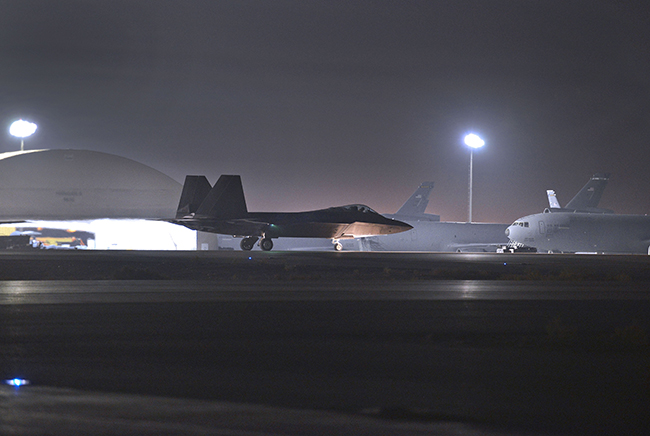An F-22 Raptor taxis during Operation Jagged Knife at Al Dhafra AB, United Arab Emirates, Nov. 19, 2017. Air Force photo by TSgt. Anthony Nelson Jr.
The short-lived air campaign targeting Taliban drug infrastructure in Afghanistan had almost no impact on Taliban operations and the US tally of costs imposed was wildly inflated, even though the operation marked the F-22’s first combat in that country and the first use of a B-52’s enhanced weapons launcher, the US government’s watchdog for Afghanistan said Wednesday.
Operation Jagged Knife kicked off in November 2017, with stealthy F-22s flying all the way from Al Dhafra AB, UAE, and B-52s from Al Udeid AB, Qatar, dropping large amounts of weapons on relatively small Taliban targets. During one mission, a B-52 set a new record for the largest number of precision munitions dropped from a Stratofortress in its history.
The US military touted the success of the campaign in early 2018, saying that in two months of operations the campaign destroyed 25 drug labs and eliminated $80 million of drug money. But even as the Defense Department was pushing these figures, John Sopko, the Special Inspector General for Afghanistan Reconstruction, said other representatives, such as the Drug Enforcement Agency, expressed skepticism about their accuracy.
Sopko told reporters on Wednesday the cost estimate was “totally exaggerated” and had “no basis” in reality. These targets, including ones the military said required the F-22’s capability to precisely employ Small Diameter Bombs, were mostly small, cheap structures that cost about $500 to make and were no bigger than a conference room table. After a “couple” of these strikes, the drug makers figured out it would be better to move them inside a mosque or another building and they were no longer targeted, he said.
The US mission in Afghanistan had said Jagged Knife was a “sustained air interdiction campaign” and it “directly strengthens the Afghan defense forces.”
On the campaign, Sopko said, “I don’t think that was successful” and it ended relatively quickly. It had no impact on the growth of the poppy crop used to produce heroin, instead it is drought and disease that have actually impacted Afghanistan’s drug production so far, he said.
The campaign was part of a large increase in US strikes inside the country. In 2017, the US airstrike total in Afghanistan was 4,361—a large increase from the previous year’s 1,337. Air operations increased even more in 2018, with a total of 7,362. The strikes have had some impact in helping bring the Taliban to the negotiating table with the US for a peace deal, though SIGAR has noted the group also has increased its presence throughout the country.

